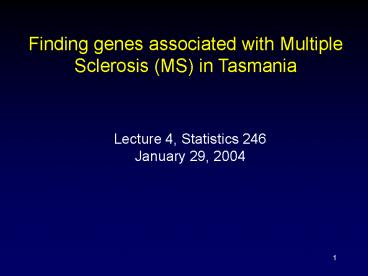Finding genes associated with Multiple Sclerosis MS in Tasmania
1 / 15
Title:
Finding genes associated with Multiple Sclerosis MS in Tasmania
Description:
To describe some of the statistical methods used in a large ... Proband. Monozygotic twins. Dizygotic twins. Full siblings. Half siblings. Cousins % of genome ... –
Number of Views:215
Avg rating:3.0/5.0
Title: Finding genes associated with Multiple Sclerosis MS in Tasmania
1
Finding genes associated with Multiple Sclerosis
(MS) in Tasmania
Lecture 4, Statistics 246 January 29, 2004
2
Aim
- To describe some of the statistical methods
used in a large project attempting to map genes
contributing to multiple sclerosis, making use of
data collected from the Australian state of
Tasmania.
3
Intro to MS
4
MS some facts
- Affects mainly Caucasians (N. Europe)
- Most common neurodegenerative disease
- of young adults (50-100 per 100,000)
- gt 200,000 people with MS in the US
- Average age at onset 28(f)/30(m) years.
- Sex bias 2 female to 1 male
- Chronic illness with cumulative disability
- Treatment expensive (gtUS10,000 p.a.)
5
MS results from progressive destruction of myelin
- Lack of myelin formation and maintenance causes
disruption of
nerve impulse conduction
6
Another schematic illustrating the same point
- As myelin is stripped from
- axons, transmission of nerve impulses are slowed
or blocked - This causes the diverse sensory, motor and
autonomic symptoms that characterise MS
7
Magnetic resonance imaging
- Areas of demyelination
- (plaques) identified by
- proton-dense signal
- High signal observed in
- periventricular regions in
- 98 of patients
8
Symptoms of MS
MS is a condition with a variety of symptoms
depending on the areas of the central nervous
system affected by de-myelination The systems
commonly affected include Vision
Co-ordination Strength Sensation Speech and
swallowing Bladder control Cognitive function
9
MS - forms of the disease
Relapsing-remitting
Secondary progressive
Primary progressive
Progressive-relapsing
10
MS genetics
11
Environment and Genes
- Environment
- MS prevalence appears to rise with increasing
geographical latitude - Children of immigrants often have same risk of
developing MS as new place of residence - Viruses have been implicated in MS pathogenesis
- Genes
- Monozygotic twin concordance rate of 30
- compared to dizygotic twin concordance rate
of 5 - MS is most common in Caucasians
- The HLA region (on chromosome 6) has been
consistently linked and associated with MS
12
MS in Australia, 1981
Mcleod et al. Med J Aust 1994
13
Environment and Genes
- Recurrence risks. We are going to digress to
go through a talk by David Clayton, one of the
world leaders in genetic epidemiology, who also
works on genes and MS. The talk is available at - www-gene.cimr.cam.ac.uk/clayton/talks/Bristol_20
03/segrec.pdf
14
Familial recurrence risks for MS
l
15
Previous genome-wide scans for MS susceptibility
genes identify the HLA region
Stage 1
Chromosomal regions with suggestive linkage
Study
Family type
Stage 2
American /French
sib-pairs
23 (3)
6p21
British
sib-pairs
98 (46)
1cen, 5cen, 6p21, 7p, 12p, 14q, 17q22, 19q, 22q
Canadian
sib-pairs
114 (8)
5p, 6p21
Finnish
multiplex families
21 (40)
2q, 3q, 4cen, 6p21, 10q, 11tel, 17q, 18tel,
19tel































